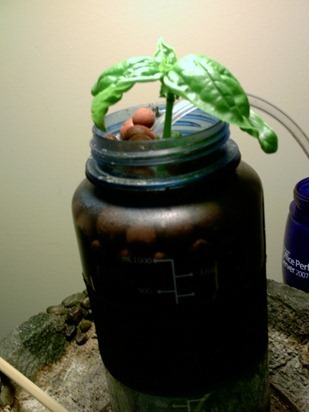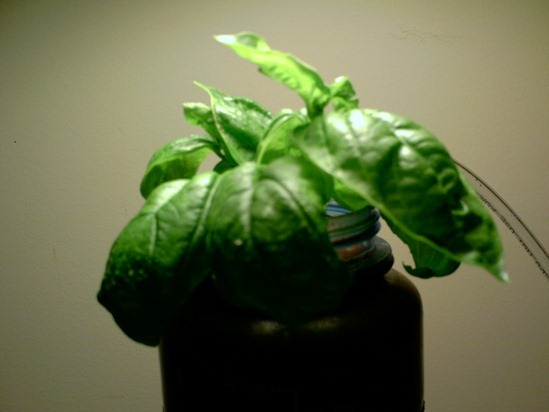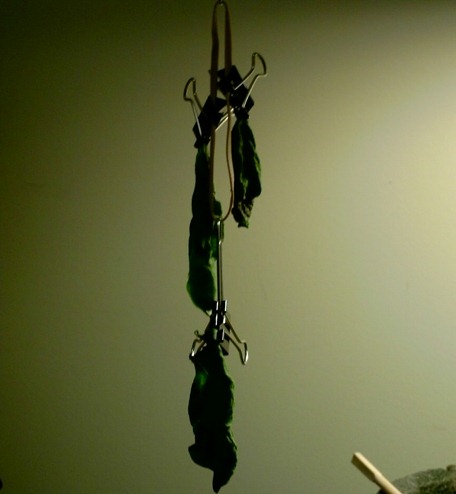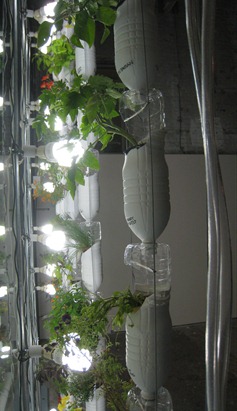Office hydroponic setup (Growing Basil in a water bottle)
13.3 years ago basil, cheap, hydroponics, office
An unfortunate thing happened to my little office basil growing experiment, I got some fungal gnats and not wanting to be the guy known for his office infested with flies I decided to throw together a little hydroponic system primarily consisting of items I had around the office.
I started with an old reusable water bottle I had previously used to store water for my prior soil based basil plant. I filled the bottle with water, added a couple of handfuls of hydrocon clay pellets, dropped in an air stone attached to a cheap aquarium pump and I have a neat little bubbler system.
After a couple of weeks there was great root growth (water is not really green just poor camera, bad lighting and unfortunate use of blue water bottle)
After a couple more weeks, when I was away for Christmas vacation I came back to a plant though needing some water was still growing strong.
For nutrients I broke off the smallest piece of some generic brand plant spike fertilizer I can put in piece in every week or so along with a small pinch of epsom salt.
When it is time to harvest, I made good of office supplies: a couple of binder clips attached to some rubber bands provides good air circulation to dry out any extra basil I want to store for later use.
Hey it is not pretty, but it is cheap and provides me some fresh basil to add to my omelets from the cafeteria downstairs and even a little extra dry basil to use at home.
Create your own hydroponic window farm
13.8 years ago cheap, hydroponics, recycle
If I didn’t have a big house blocking my southern exposed window, otherwise I would have completely tried this myself. The basic idea is to take come recycled plastic bottles, use an air pump and some tubing to create an air water pump to push the nutrients to the top and gravity takes care of the rest.
The great part of this is that it is an open design community making and sharing new innovations as they are discovered. Here are the complete instructions of the most recent (version 3) of their system. They also offer a complete kit if you want to save some time with assembly.
Via LifeHacker [via Window Farms]
Ultimate Aquaponics setup
13.9 years ago aquaponics, herbs, hydroponics, indoor growbox
I actually thought I already posted about this bad boy which unfortunately is only a design concept from Philips. For those that are not familiar:
Aquaponics is the symbiotic cultivation of plants and aquatic animals in a recirculating environment.
Aquatic animal effluent (for example fish waste) accumulates in water as a by-product of keeping them in a closed system or tank (for example a recirculating aquaculture system). The effluent-rich water becomes high in plant nutrients but this is correspondingly toxic to the aquatic animal.
Source Wikipedia
This system is called the BioTower, the first 2 levels are hydroponic plants with the third being algae. The fourth layer contains shrimp and fish which produce organic waste which is stored in the bottom layer.
The lights are powered using optical fibers from the sun and the methane from the organic waste powers the lights at night. The plants and seafood can then be consumed all powered by the various ecosystems.
I couldn’t even imagine what something like this would cost if it came out of the design phase, though a simple cover over the organic waste and this would make a great conversation piece.
Cost of Hydroponic Nutrients
14.3 years ago cheap, hydroponics, nutrients
The first time you walk into a hydroponic store there can be a little sticker shock. At first it doesn’t look too bad, $14 for this bottle…oh wait I have to buy these three as well and you leave the store paying $80 to grow some basil and lettuce. Being cheap I like to know how much I will be spending on a hobby before I start out so I did a little exercise.
I took a look at the major nutrient manufacturers and determined using their recommended feeding schedule what it would cost per gallon to complete a 4 week vegetation cycle and a 8 week vegetable and bloom cycle.
To be fair I only included products that provided the primary/secondary macronutrients and micronutrients. Though I am not discounting the effectiveness of various supplements that these companies provide and I wanted to stick with the basics and have a close to an apples to apples comparison as possible.
| Avg, Price | Size | Nutrients Used over 4 weeks (Veg Only) |
Cost per Gallon of mixed nutrients | Nutrients Used over 8 weeks (Veg/Bloom) |
Cost per Gallon of mixed nutrients | |
| General Hydroponics |
$ 1.08 | $ 2.80 | ||||
| FloraGrow | $ 12.50 | qt | 8.08 tsp | $ 0.53 | 12.12 tsp | $ 0.79 |
| FloraBloom | $ 12.50 | qt | 2.02 tsp | $ 0.13 | 14.14 tsp | $ 0.92 |
| FloraMicro | $ 15.95 | qt | 5.05 tsp | $ 0.42 | 13.13 tsp | $ 1.09 |
| Dutch Nutrient Formula |
$ 0.82 | $ 2.30 | ||||
| Advance Grow A |
$ 7.50 | L | 11 tsp | $ 0.41 | 11 tsp | $ 0.41 |
| Advance Grow B |
$ 7.50 | L | 11 tsp | $ 0.41 | 11 tsp | $ 0.41 |
| Advance Flower A |
$ 7.50 | L | 0 tsp | $ – | 20 tsp | $ 0.74 |
| Advance Flower B |
$ 7.50 | L | 0 tsp | $ – | 20 tsp | $ 0.74 |
| Dyna-Gro |
$ 0.66 | $ 2.03 | ||||
| Liquid Grow |
$ 15.00 | qt | 3.5 tsp | $ 0.27 | 3.5 tsp | $ 0.27 |
| Liquid Bloom |
$ 18.95 | qt | 0 tsp | $ – | 7 tsp | $ 0.69 |
| Mag-Pro |
$ 17.95 | qt | 0.875 tsp | $ 0.08 | 3.875 tsp | $ 0.36 |
| Pro-TeKt |
$ 13.90 | qt | 4.25 tsp | $ 0.31 | 9.75 tsp | $ 0.71 |
At first glance these numbers look pretty promising, until you remember the fact that this is the cost per gallon. So if you had a 40 gallon reservoir this can make your cost obvious jump up significantly. Fortunately in my case I only fill my tank up to 9 gallons so a 4 week cycle would cost me on average $7.68 for a 4 week vegetative cycle or $21.39 for a 8 week vegetative and bloom cycle.
Now given I am planning on growing some legal herbs in my hydroponic system (basil/oregano/cilantro) and maybe a little lettuce. This would result in some pretty expensive produce. For this reason and that fact I love chemistry and don’t get to play with it much these days I am planning on going for the less expensive homemade nutrient route, which I will provide more details once I get some more conclusive results of success or failure…
Tags: cheap, cilantro, herb garden, vegetables
pH needs of plants in soil or hydroponics
14.3 years ago hydroponics, pH, water
With the exception of some of my acid loving plants and flowers I normally do not have to worry much about the pH of my soil. This is because I have amended my gardens with nutrient rich soils in raised beds over my alkaline clay I get naturally in my area. This and the fact that due to natural and manmade causes the rainfall is slightly acidic and given the average range for the sweet spot of most edible vegetables (see table below) is 5.8 to 6.0 having your soil slightly acidic this is perfect.
Now when it comes to hydroponics this is entirely different. My tap water has a pH of around 7.5 and the fluctuation of plant using nutrients and transpiration can cause great havoc on the pH on your hydroponic system. Now this creates a challenge but also an opportunity to have control with great precision your pH and keep your plants growing in the sweet spot for the healthiest plants and the greatest yields.
So whether you are growing hydroponically, or simply trying to figure out why your Fennel didn’t do so well last year take a look at the table below, hopefully for some hints of what happened.
Recommended pH Ranges of Vegetables/Herbs
| Plant | Low | High | Plant | Low | High | |
| Artichoke | 6.5 | 7.5 | Millet | 6.0 | 6.5 | |
| Asparagus | 6.0 | 8.0 | Mint | 7.0 | 8.0 | |
| Average | 6.3 | 7.8 | Mushroom | 6.5 | 7.5 | |
| Basil | 5.5 | 6.5 | Mustard | 6.0 | 7.5 | |
| Bean | 6.0 | 7.5 | Okra | 5.5 | 6.0 | |
| Beanroot | 6.0 | 7.5 | Olive | 5.5 | 6.5 | |
| Beet | 6.0 | 6.8 | Onion | 5.5 | 6.5 | |
| Broccoli | 6.0 | 6.8 | Paprika | 7.0 | 8.5 | |
| Brussel Sprouts | 6.0 | 6.8 | Parsley | 5.0 | 7.0 | |
| Cabbage | 6.0 | 6.8 | Parsnip | 6.0 | 6.8 | |
| Calabrese | 6.5 | 7.5 | Pea | 5.8 | 7.0 | |
| Carrot | 6.0 | 6.8 | Peanut | 5.0 | 6.5 | |
| Cauliflower | 6.0 | 6.8 | Pepper | 5.5 | 6.0 | |
| Celery | 6.0 | 6.5 | Peppermint | 6.0 | 7.5 | |
| Chicory | 5.0 | 6.5 | Pistacio | 5.0 | 6.0 | |
| Chinese Cabbage | 6.0 | 7.5 | Potato | 4.5 | 6.5 | |
| Chives | 6.0 | 7.0 | Potato, Sweet | 4.5 | 6.0 | |
| Corn Salad | 6.0 | 6.5 | Pumpkin | 6.0 | 6.8 | |
| Corn, Sweet | 5.8 | 6.8 | Radish | 6.0 | 6.8 | |
| Courgettes | 5.5 | 7.0 | Rice | 5.0 | 6.5 | |
| Cress | 6.0 | 7.0 | Rosemary | 5.0 | 6.0 | |
| Cucumber | 6.0 | 6.8 | Rutabaga | 6.0 | 6.8 | |
| Eggplant | 5.5 | 6.0 | Sage | 5.5 | 6.5 | |
| Fennel | 5.0 | 6.0 | Shallot | 5.5 | 7.0 | |
| Garlic | 5.5 | 7.5 | Sorghum | 5.5 | 7.5 | |
| Ginger | 6.0 | 8.0 | Soybean | 5.5 | 6.5 | |
| Horseradish | 6.0 | 7.0 | Spearmint | 5.5 | 7.5 | |
| Kale | 6.0 | 7.5 | Spinach | 6.0 | 6.5 | |
| Kohlrabi | 6.0 | 6.8 | Squash | 6.0 | 6.8 | |
| Leek | 6.0 | 8.0 | Swede | 5.5 | 7.0 | |
| Lentil | 5.5 | 7.0 | Swiss Chard | 6.0 | 6.5 | |
| Lettuce | 6.0 | 6.5 | Thyme | 5.5 | 7.0 | |
| Marjoram | 6.0 | 7.5 | Tomato | 6.0 | 6.5 | |
| Marrow | 6.0 | 7.5 | Turnip | 6.0 | 6.8 | |
| Melon | 6.0 | 6.8 | Upland Cress | 6.0 | 6.5 |
Tags: garlic bulbs, herb garden, outdoor plants, pepper plants, peppermint plant, tomato plants, vegetables
Cheap Hydroponic Bean sprouter
14.3 years ago cheap, ebb and flow, hydroponics
Maybe not the most hygienic solution but definitely cheap, innovative, and low maintenance. I’ll stick to my ebb and flow design, but thought I would share for those feeling adventurous.
Tags: cheap, outdoor plants, vegetables









